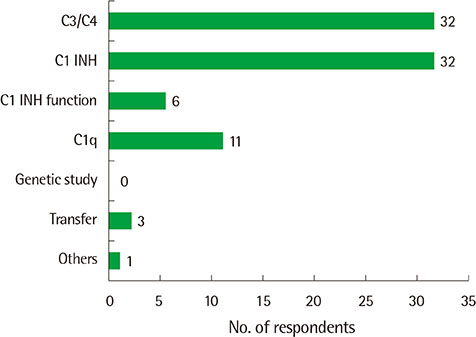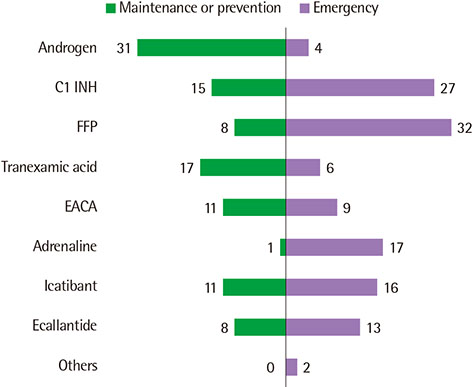Allergy Asthma Respir Dis.
2014 Sep;2(4):277-284. 10.4168/aard.2014.2.4.277.
Clinical experience in managing patients with hereditary angioedema in Korea: questionnaire survey and a literature review
- Affiliations
-
- 1Department of Internal Medicine, Seoul National University College of Medicine, Seoul, Korea. helenmed@snu.ac.kr, drmin@snu.ac.kr
- 2Department of Internal Medicine, Chung-Ang University College of Medicine, Seoul, Korea.
- 3Department of Pediatrics, National Health Insurance Corporation Ilsan Hospital, Goyang, Korea.
- 4Department of Pediatrics and Adolescent Medicine, Ajou University School of Medicine, Suwon, Korea.
- 5Department of Pediatrics, Eulji University School of Medicine, Daejeon, Korea.
- KMID: 2262396
- DOI: http://doi.org/10.4168/aard.2014.2.4.277
Abstract
- PURPOSE
Hereditary angioedema is a familial disease which is caused by a genetic deficiency or functional defect of the C1 inhibitor, and it features episodic swelling that can affect any part of the body. A great number of patients are estimated not to have an accurate diagnosis after the onset of symptoms, and close attention is required because sudden hereditary angioedema attacks can result in even death.
METHODS
We sent an e-mail questionnaire to 975 members of the Korean Academy of Asthma, Allergy and Clinical Immunology. A total of 82 members replied. The questionnaire, including 15 questions about the diagnosis and management of hereditary angioedema, was developed by the anaphylaxis/urticaria, angioedema workgroup of the Korean Academy of Asthma, Allergy and Clinical Immunology.
RESULTS
Forty-two percent of the respondents had experience with treatment of a suspected case of hereditary angioedema, and 15.9% made a confirmed diagnosis of hereditary angioedema. When the respondents suspected of cases, 91.4% of them performed tests for C3 and C4 concentrations and C1 inhibitor level. For maintenance treatment, most of the respondents used androgen, and only 22% found that C1 inhibitor concentrates can be prescribed through the Korea Orphan Drug Center in Korea.
CONCLUSION
Allergy physicians in Korea substantially recognized the correct diagnosis and treatment of hereditary angioedema. However, there was a lack of awareness for the latest treatments, such as C1 inhibitor concentrates. Education of doctors and the public is needed.
MeSH Terms
Figure
Reference
-
1. Davis AE 3rd. The pathophysiology of hereditary angioedema. Clin Immunol. 2005; 114:3–9.
Article2. Longhurst H, Cicardi M. Hereditary angio-oedema. Lancet. 2012; 379:474–481.
Article3. Bygum A. Hereditary angio-oedema in Denmark: a nationwide survey. Br J Dermatol. 2009; 161:1153–1158.
Article4. Roche O, Blanch A, Caballero T, Sastre N, Callejo D, Lopez-Trascasa M. Hereditary angioedema due to C1 inhibitor deficiency: patient registry and approach to the prevalence in Spain. Ann Allergy Asthma Immunol. 2005; 94:498–503.
Article5. Agostoni A, Cicardi M. Hereditary and acquired C1-inhibitor deficiency: biological and clinical characteristics in 235 patients. Medicine (Baltimore). 1992; 71:206–215.6. Bork K, Hardt J, Schicketanz KH, Ressel N. Clinical studies of sudden upper airway obstruction in patients with hereditary angioedema due to C1 esterase inhibitor deficiency. Arch Intern Med. 2003; 163:1229–1235.
Article7. Gompels MM, Lock RJ, Morgan JE, Osborne J, Brown A, Virgo PF. A multicentre evaluation of the diagnostic efficiency of serological investigations for C1 inhibitor deficiency. J Clin Pathol. 2002; 55:145–147.
Article8. Tosi M. Molecular genetics of C1 inhibitor. Immunobiology. 1998; 199:358–365.
Article9. Warin RP, Cunliffe WJ, Greaves MW, Wallington TB. Recurrent angioedema: familial and oestrogen-induced. Br J Dermatol. 1986; 115:731–734.
Article10. Vitrat-Hincky V, Gompel A, Dumestre-Perard C, Boccon-Gibod I, Drouet C, Cesbron JY, et al. Type III hereditary angio-oedema: clinical and biological features in a French cohort. Allergy. 2010; 65:1331–1336.
Article11. Bork K, Wulff K, Hardt J, Witzke G, Staubach P. Hereditary angioedema caused by missense mutations in the factor XII gene: clinical features, trigger factors, and therapy. J Allergy Clin Immunol. 2009; 124:129–134.
Article12. Bork K, Wulff K, Meinke P, Wagner N, Hardt J, Witzke G. A novel mutation in the coagulation factor 12 gene in subjects with hereditary angioedema and normal C1-inhibitor. Clin Immunol. 2011; 141:31–35.
Article13. Bygum A, Vestergaard H. Acquired angioedema: occurrence, clinical features and associated disorders in a Danish nationwide patient cohort. Int Arch Allergy Immunol. 2013; 162:149–155.
Article14. Cicardi M, Zanichelli A. Acquired angioedema. Allergy Asthma Clin Immunol. 2010; 6:14.
Article15. Agostoni A, Aygoren-Pursun E, Binkley KE, Blanch A, Bork K, Bouillet L, et al. Hereditary and acquired angioedema: problems and progress: proceedings of the third C1 esterase inhibitor deficiency workshop and beyond. J Allergy Clin Immunol. 2004; 114:3 Suppl. S51–S131.
Article16. Lee JH, Cho JY, Nam DH, Hong CS. A case of hereditary angioedema. Allergy. 1994; 14:695–701.17. Lee YS, Chung JH, Cho KH, Youn JI. A case of hereditary angioedema. Korean J Dermatol. 1994; 32:115–118.18. Suh KS, Kang JM, Kim KJ, Kang HJ. Three cases of hereditary angioedema in one family. Korean J Dermatol. 1995; 33:564–569.19. Lee JA, Nah BG, Jun H, Seo JC, Kim MK. A case of hereditary angioedema not manifestated classical autosomal dominant trait. Korean J Allergy. 1997; 17:574–579.20. Kim SH, Lee BJ, Chang YS, Kim YK, Cho SH, Min KU, et al. A case of hereditary angioedema associated with idiopathic hypoparathyroidism. Korean J Intern Med. 2001; 16:281–283.
Article21. Kang HR, Yim EY, Oh SY, Chang YS, Kim YK, Cho SH, et al. Normal C1 inhibitor mRNA expression level in type I hereditary angioedema patients: newly found C1 inhibitor gene mutations. Allergy. 2006; 61:260–264.
Article22. Shin M, Ahn K. A case of hereditary angioedema in a 7-year-old korean girl. Allergy Asthma Immunol Res. 2013; 5:59–61.
Article23. Lee SY, Lee SE, Kim MH, Song WJ, Kang HR, Min KU. A case of cesarean section delivery in a patient with hereditary angioedema. Korean J Asthma Allergy Clin Immunol. 2012; 32:264–267.24. Jung JW, Kim YJ, Yang MS, Kim MH, Song WJ, Kim TW, et al. Clinical characteristics of hereditary angioedema patients in single tertiary hospital in Korea [abstract]. In : Fall conference of the Korean Association of Internal Medicine; 2011 Oct 22; Seoul, Korea. Seoul: Korean Association of Internal Medicine;2011. 1:p. 318.25. Wagenaar-Bos IG, Drouet C, Aygoren-Pursun E, Bork K, Bucher C, Bygum A, et al. Functional C1-inhibitor diagnostics in hereditary angioedema: assay evaluation and recommendations. J Immunol Methods. 2008; 338:14–20.
Article26. Iwamoto K, Mihara S, Ikezawa Z, Hide M. National prevalence survey of hereditary angioedema in Japan. Arerugi. 2011; 60:26–32.27. Cicardi M, Bork K, Caballero T, Craig T, Li HH, Longhurst H, et al. Evidence-based recommendations for the therapeutic management of angioedema owing to hereditary C1 inhibitor deficiency: consensus report of an International Working Group. Allergy. 2012; 67:147–157.
Article28. Zuraw BL, Busse PJ, White M, Jacobs J, Lumry W, Baker J, et al. Nanofiltered C1 inhibitor concentrate for treatment of hereditary angioedema. N Engl J Med. 2010; 363:513–522.
Article29. Bork K, Siedlecki K, Bosch S, Schopf RE, Kreuz W. Asphyxiation by laryngeal edema in patients with hereditary angioedema. Mayo Clin Proc. 2000; 75:349–354.
Article30. Zuraw BL. Clinical practice. Hereditary angioedema. N Engl J Med. 2008; 359:1027–1036.31. Lim YC, Kim JK, Shim DB, Lim CH, Jang HJ, Shin HA, et al. Hereditary angioneurotic edema of the larynx. Acta Otolaryngol. 2005; 125:1240–1243.
Article32. Chung JY, Kim M. Migraine-like headache in a patient with complement 1 inhibitor deficient hereditary angioedema. J Korean Med Sci. 2012; 27:104–106.
Article
- Full Text Links
- Actions
-
Cited
- CITED
-
- Close
- Share
- Similar articles
-
- Hereditary Angioneurotic Edema of the Larynx: A Case Report and Literature Review
- A Case of Hereditary Angioedema
- ERRATUM: Correction of explanation for footnote in Table 3. Clinical experience in managing patients with hereditary angioedema in Korea: questionnaire survey and a literature review
- A case of Hereditary Angioedema Associated with Idiopathic Hypoparathyroidism
- Perioperative management of a patient with hereditary angioedema undergoing oral surgery





